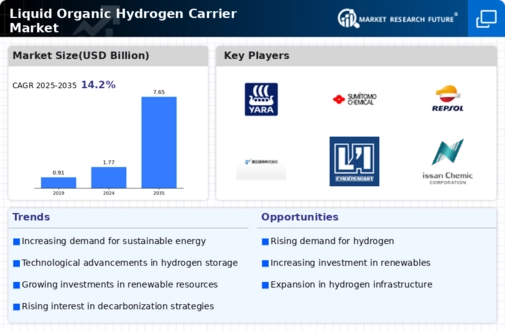Market Growth Projections
Rising Awareness of Energy Security
Energy security concerns are becoming increasingly prominent, driving interest in the Global Liquid Organic Hydrogen Carrier Market Industry. Countries are seeking to diversify their energy sources to reduce dependence on fossil fuels and enhance energy resilience. Hydrogen, particularly when derived from renewable sources, offers a promising solution to these challenges. The potential for hydrogen to be produced domestically reduces reliance on imported fuels, thereby contributing to national energy security. This growing awareness is likely to stimulate investments and policy support, fostering a conducive environment for market expansion.
Growing Demand for Clean Energy Solutions
The Global Liquid Organic Hydrogen Carrier Market Industry experiences a surge in demand driven by the global transition towards clean energy solutions. Governments worldwide are implementing stringent regulations aimed at reducing carbon emissions, which propels the adoption of hydrogen as a clean fuel alternative. The market is projected to reach 1.77 USD Billion in 2024, reflecting a growing recognition of hydrogen's potential in decarbonizing various sectors, including transportation and industrial processes. This shift not only aligns with climate goals but also encourages investments in hydrogen infrastructure, thereby enhancing the market's growth trajectory.
Supportive Government Policies and Incentives
Supportive government policies and incentives are crucial for the growth of the Global Liquid Organic Hydrogen Carrier Market Industry. Many governments are introducing favorable regulations and financial incentives to promote hydrogen technologies and infrastructure development. These initiatives are designed to accelerate the transition to a hydrogen economy, encouraging research and development as well as commercial deployment. As countries commit to achieving net-zero emissions targets, the role of hydrogen is expected to become more pronounced, further enhancing the market's growth prospects.
Technological Advancements in Hydrogen Storage
Technological innovations play a pivotal role in the Global Liquid Organic Hydrogen Carrier Market Industry, particularly in the development of efficient hydrogen storage solutions. Advances in materials science and engineering have led to the creation of more effective liquid organic hydrogen carriers, which enhance the safety and efficiency of hydrogen transport. These innovations are crucial as they address the challenges associated with hydrogen storage and distribution, making it more viable for widespread use. As these technologies continue to evolve, they are likely to attract significant investment, further propelling market growth and expanding application areas.
Increasing Investment in Hydrogen Infrastructure
The Global Liquid Organic Hydrogen Carrier Market Industry benefits from increasing investments in hydrogen infrastructure, which are essential for the development of a robust hydrogen economy. Governments and private entities are channeling funds into the establishment of production, storage, and distribution facilities. This influx of capital is expected to facilitate the scaling up of hydrogen production capabilities, thereby meeting the anticipated demand. By 2035, the market is projected to reach 7.65 USD Billion, indicating a strong commitment to building the necessary infrastructure to support hydrogen as a mainstream energy source.





















